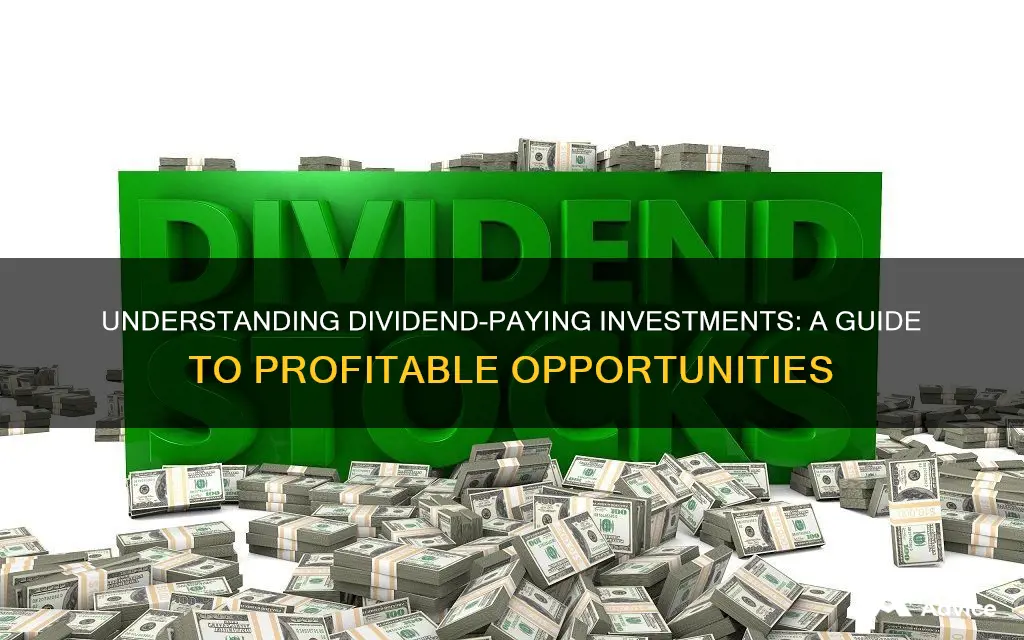
Dividend stocks are shares of companies that pay investors a portion of their earnings, and they can be a great choice for investors seeking passive income. Dividend-paying companies tend to be well-established, offering stability to an investment portfolio. Dividend stocks can be purchased individually or through funds or exchange-traded funds (ETFs).
Dividends are typically paid out annually, semi-annually, or quarterly, but some companies distribute dividends monthly. Dividend yields, a key metric for understanding dividend stocks, are calculated by dividing the annual dividend per share by the stock's price.
When investing in dividend stocks, it is crucial to assess the reliability of dividend payments and opt for companies with a track record of stable and growing dividends. Additionally, investors should be cautious of excessively high yields, as they may indicate potential risks or issues within the company.
What You'll Learn

Dividend stocks vs dividend funds
Dividend stocks and dividend funds are two ways to invest in dividend-paying stocks. Dividend stocks are individual stocks that pay dividends, while dividend funds are funds that invest in a portfolio of dividend-paying stocks. Here are some key differences between the two:
Diversification
Dividend funds provide greater diversification than dividend stocks. By investing in a fund, you gain exposure to multiple dividend-paying stocks across different sectors, reducing the risk associated with investing in a single stock.
Income Consistency
Dividend funds are designed to provide consistent income by investing in stocks with a history of paying dividends. While individual dividend stocks may also pay dividends, their payouts may be less consistent and can be reduced or eliminated at any time.
Expense Ratios
Dividend funds typically have lower expense ratios than actively managed funds and may have lower costs than buying a diversified portfolio of individual dividend stocks.
Management
Dividend funds are managed by professional fund managers who make investment decisions on behalf of the investors. With dividend stocks, investors need to make their own investment decisions and conduct thorough research on each stock.
Risk
While dividend funds provide greater diversification and may be less risky, they are still subject to market risk and can experience declines in value. Dividend stocks, on the other hand, carry the risk of company-specific factors such as poor financial performance or negative news, which can impact the stock's value.
Performance
The performance of dividend funds and individual dividend stocks depends on various factors, including the specific stocks, investment strategy, and market conditions. Dividend funds may provide more stable income, while individual dividend stocks may offer higher growth potential.
In summary, dividend funds offer instant diversification, consistent income, and lower costs, while dividend stocks allow investors to build a custom portfolio, make their own investment decisions, and potentially achieve higher returns. The choice between dividend stocks and dividend funds depends on an investor's financial goals, risk tolerance, and investment style.
Rights: Investing's Golden Ticket
You may want to see also

Dividend yield
A dividend yield of 5% on a share valued at $100, for example, means the company will pay you $5 each year in dividend income.
When comparing stocks within the same industry, investors should look for those with higher dividend yields. However, excessively high yields may indicate potential risks or issues with the company. For instance, a company with a declining share price may be facing problems and might need to reconsider its dividend policy.
Should You Invest Now?
You may want to see also

Dividend reinvestment
DRIPs are a good strategy for investors to see growth in their portfolios through compounding returns. By reinvesting dividends, investors can buy more shares with the dividend that they're paid, rather than pocketing the cash. This can help build wealth over time.
DRIPs are also advantageous because they are:
- Cheap: There are no commissions or other brokerage fees when buying more shares.
- Easy: Dividend reinvestment is automatic once it's set up.
- Flexible: Investors can buy fractional shares, which brokers usually don't allow.
- Consistent: Shares are bought on a regular basis—every time a dividend is received.
There are some disadvantages to DRIPs. Reinvesting dividends means investors don't receive the cash from the dividend, which could be used for other purposes, such as spending it or investing it elsewhere. There are also tax implications, as dividends paid into DRIPs are taxed, even though they are used to purchase shares.
Some companies that offer DRIPs include:
- 3M
- Verizon Communications Inc.
- Johnson & Johnson
- Chevron
- Cisco Systems Inc.
Utilities: Invest or Avoid?
You may want to see also

Dividend income tax
Dividend Income from Shares or Mutual Funds:
Before the Finance Act of 2020, dividends were exempt from tax as the company or mutual fund paying the dividend was liable to pay Dividend Distribution Tax (DDT). However, the Finance Act of 2020 abolished DDT and shifted the tax burden to the recipient. Now, dividends received by individuals, Hindu Undivided Families (HUFs), and firms from domestic companies and mutual funds are taxed according to the applicable Income Tax slab rates.
For example, if an individual falls under the 30% tax bracket and receives a dividend of ₹15,000, they would be liable to pay ₹4,500 (30% of ₹15,000) as tax on dividends. It is essential for investors to consider this tax implication when planning their investments and expected returns.
Additionally, a Tax Deducted at Source (TDS) of 10% is applicable on dividend income exceeding ₹5,000 in a financial year. This means that if an individual receives dividends amounting to ₹15,000, a TDS of ₹1,000 (10% of ₹10,000, as the first ₹5,000 is exempt) would be deducted at the source. However, this TDS can be adjusted against the total tax liability when filing the income tax return.
When filing income tax returns, dividend income needs to be reported under the 'Income from Other Sources' head in the ITR form. Taxpayers can claim a deduction of up to 20% of the gross dividend income towards interest expenses incurred to earn such dividend income, but no other expenses are deductible.
Dividend Income for Non-Resident Indians (NRIs):
For NRIs receiving dividends from Indian shares and mutual funds, the tax treatment is different. TDS under Section 195 is deducted at a rate of 20% and is subject to the Double Taxation Avoidance Agreement (DTAA), if applicable. To avail of the benefit of a lower DTAA treaty rate, the non-resident must submit relevant documents. In the absence of such documents, a higher TDS is deducted, which can be claimed at the time of filing the income tax return.
Qualified Dividends:
Qualified dividends are ordinary dividends that meet specific criteria to be taxed at capital gains tax rates, which are lower than income tax rates for some taxpayers. For the 2023 tax year, individuals earning over $44,625 or married couples filing jointly with earnings over $89,250 pay a minimum of 15% tax on capital gains. The maximum tax rate for qualified dividends is 20%, with some exceptions for real estate, art, or small business stock.
To be considered a qualified dividend, the shareholder must hold the stock for more than 60 days in the 121-day period beginning 60 days before the ex-dividend date. The ex-dividend date is one market day before the dividend's record date, which is when a shareholder must be on the company's books to receive the dividend.
Ordinary Dividends:
Ordinary dividends are taxed at income tax rates, which, as of the 2023 tax year, max out at 37%. Ordinary dividends are regular payments made by a company to shareholders and are taxed as ordinary income.
Is it wise to invest now?
You may want to see also

Dividend aristocrats
To be a dividend aristocrat, a company must have 25+ consecutive years of dividend increases and meet certain minimum size and liquidity requirements. There are currently 68 dividend aristocrats, including Johnson & Johnson, Medtronic, and Chevron.
The top 2 sectors by weight in the Dividend Aristocrats are Industrials and Consumer Staples, which together make up over 40% of the Dividend Aristocrats Index but less than 20% of the S&P 500. The Dividend Aristocrats Index is also underweight in the Information Technology sector.
Tesla: The Future of Electric Cars
You may want to see also
Frequently asked questions
Dividend stocks are shares of companies that regularly pay investors a portion of the company's earnings. Some pay dividends annually, semi-annually or quarterly, while others are monthly dividend stocks.
Investing in dividend stocks is a long-term strategy. Look for companies with a track record of stable and growing dividends. Compare the dividend yield of different stocks within the same industry to identify those with higher yields.
Dividends are never guaranteed. Companies can and do reduce or even eliminate their dividends. During the Covid-19 pandemic, some prominent companies did so, including Wells Fargo and Carnival.
Some examples of good dividend stocks include Johnson & Johnson, Verizon Communications, and Exxon Mobil.
Dividend capture is a hands-on approach to harvesting dividend income. With dividend capture, you buy stocks right before the dividend is paid out, then sell them again after you've been paid.







